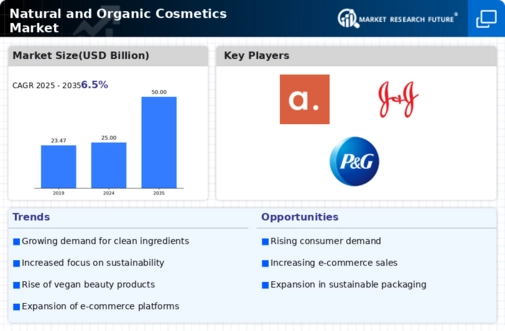Rising Awareness of Skin Health
There is a growing awareness among consumers regarding the importance of skin health, which is significantly impacting the cosmetic products market. This trend is characterized by an increasing preference for products that not only enhance beauty but also provide skincare benefits. For instance, the market for skincare-infused cosmetics is projected to grow by approximately 12% annually. Consumers are now seeking multifunctional products that combine makeup with skincare properties, such as moisturizers and sunscreens. This shift is prompting brands to innovate and develop hybrid products that cater to this demand. As a result, the cosmetic products market is evolving to include a wider range of offerings that prioritize skin health, reflecting a broader understanding of beauty as a holistic concept.
Expansion of E-commerce Platforms
The expansion of e-commerce platforms is reshaping the landscape of the cosmetic products market. With the convenience of online shopping, consumers are increasingly turning to digital channels for their beauty purchases. Recent data indicates that online sales of cosmetic products have surged, accounting for nearly 30% of total sales in the market. This trend is driven by the ease of access to a wider variety of products, competitive pricing, and the ability to read reviews before making a purchase. Additionally, brands are investing in their online presence, optimizing their websites for user experience, and utilizing data analytics to understand consumer behavior better. As e-commerce continues to grow, it is likely to play a crucial role in the future of the cosmetic products market.
Focus on Inclusivity and Diversity
The cosmetic products market is increasingly focusing on inclusivity and diversity, reflecting a broader societal shift towards representation. Brands are expanding their product lines to cater to a wider range of skin tones and types, recognizing the importance of diversity in beauty. This trend is evidenced by the introduction of foundations in an extensive array of shades, appealing to consumers who have historically been underserved. Market data suggests that brands that prioritize inclusivity are likely to capture a larger share of the market, as consumers gravitate towards companies that reflect their values. Furthermore, this focus on diversity is not limited to product offerings; it also extends to marketing campaigns that celebrate different cultures and identities. As a result, the cosmetic products market is evolving to become more representative and inclusive.
Growing Demand for Natural Ingredients
The cosmetic products market is experiencing a notable shift towards natural and organic ingredients. Consumers are increasingly aware of the potential harmful effects of synthetic chemicals, leading to a surge in demand for products that feature natural components. This trend is reflected in the market data, which indicates that the segment of natural cosmetics is projected to grow at a CAGR of approximately 8% over the next five years. As a result, brands are reformulating their products to align with this consumer preference, thereby enhancing their market presence. The growing demand for transparency in ingredient sourcing further drives this trend, compelling manufacturers to disclose their formulations. This shift not only caters to health-conscious consumers but also aligns with the broader movement towards sustainability within the cosmetic products market.
Influence of Social Media and Digital Marketing
The rise of social media platforms has transformed the way brands engage with consumers in the cosmetic products market. Influencers and beauty gurus play a pivotal role in shaping consumer preferences, often driving trends and product launches. Data suggests that approximately 70% of millennials are influenced by social media when making purchasing decisions related to cosmetics. This dynamic has prompted brands to invest heavily in digital marketing strategies, including targeted ads and influencer partnerships, to reach their audience effectively. The ability to showcase products through tutorials and reviews on platforms like Instagram and TikTok has created a more interactive shopping experience. Consequently, brands that leverage social media effectively are likely to gain a competitive edge in the cosmetic products market.














Leave a Comment